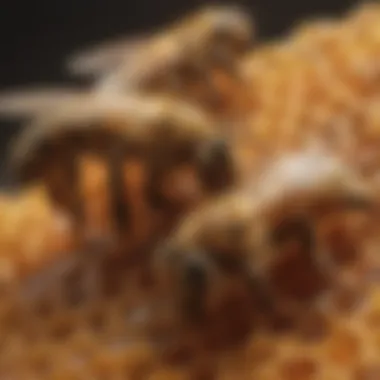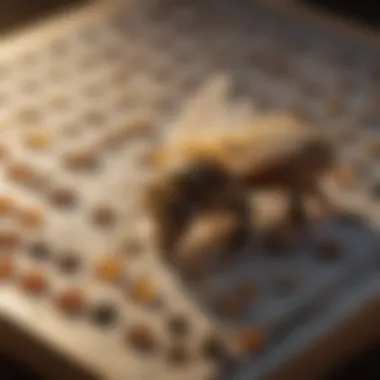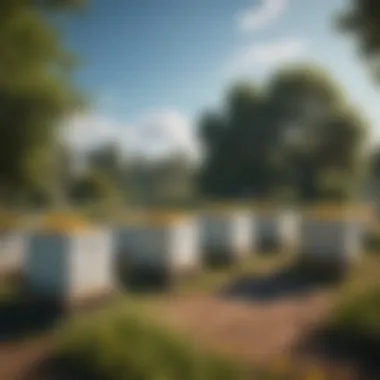Understanding the Financial Aspects of Beekeeping


Intro
Beginning a honey bee hive can be both an exciting venture and a considerable investment. Understanding the costs involved is crucial for prospective beekeepers. From the initial expenses related to setting up the hive to ongoing management costs, many factors influence the total financial commitment. Organizations and individuals often underestimate the financial responsibilities of beekeeping, leading to disillusionment later. This section aims to clarify those costs, providing a thorough perspective on what it takes financially to maintain a sustainable honey bee hive.
Initial Investments
Equipment Costs
Starting off, a primary financial obligation is the purchase of equipment. The essentials include a hive, protective gear, tools, and a bee smoker. Here’s a basic breakdown of initial equipment costs:
- Bee Hive: Wooden hives can range from $200 to $500 depending on size and material. Popular choices are Langstroth hives, which provide good accessibility.
- Protective Gear: A bee suit, gloves, and a veil generally total around $50 to $150.
- Tools: Essential tools like hive tools and a smoker cost approximately $50 to $100 combined.
This initial investment can accumulate quickly, so budgeting carefully is key.
Bees
After acquiring equipment, the next major cost involves bees. Propagating your own bees is more complex and time-consuming than buying, so many beginners purchase established bee packages or nucleus colonies. The price range for a package of bees is typically between $100 and $200, depending on the breed and local suppliers. For example, Italian bees are well-liked for their gentleness and productivity.
Health Maintenance
Beekeeping involves understanding bee health. Initial examinations, treatments, and setting a health management plan are advisable, costing around $50 to $100 annually. Keeping abreast of diseases such as Varroa mites is essential for any successful apiary.
Ongoing Expenses
Once the hive is established, there are recurring costs to consider for effective management. These regular expenses include:
- Feeding: In certain seasons, bees may require additional sugar syrup or protein supplements, costing about $30 to $100 annually.
- Medication: Treatments for pest management and diseases may come to around $50 to $150 yearly.
- Equipment Maintenance: Replacing parts of the hive or additional tools could sum to about $50 annually.
Regular monitoring and maintenance help avoid larger issues later. Every beekeeper should anticipate these ongoing costs as part of their management strategy.
Potential Income
While beekeeping can be costly, it can also yield income. Selling honey, beeswax, and related products may provide a return on your investment. A successful hive harvest can yield approximately 40 to 60 pounds of honey annually, with prices around $5 to $10 per pound in retail markets.
Income factors such as local market demand and competition will influence your profit margins. Thus, it is critical to analyze your market before diving deep into beekeeping as a financial venture.
Epilogue
In summary, starting a honey bee hive involves various initial and ongoing costs that can accumulate significantly. Understanding these costs ensures that beekeepers are prepared and informed in their decision-making process. Educating oneself on this financial commitment is not merely about budgeting; it’s integral to fostering sustainable beekeeping practices that can thrive in the long term.
Prelims to Beekeeping Costs
Understanding beekeeping costs is a vital aspect for anyone considering starting a honey bee hive. It provides a necessary framework for potential beekeepers to prepare financially and to avoid unexpected financial burdens down the line. By addressing both the initial and ongoing expenses, individuals can have realistic expectations about the total investment required.
The Importance of Understanding Costs
Being informed about the costs associated with beekeeping is crucial. A detailed understanding allows prospective beekeepers to plan their budgets effectively. Knowing where the money will go helps prevent financial surprises. This knowledge is significant for ensuring sustainability and for managing the beekeeping lifestyle without stress. Furthermore, understanding these costs gives beekeepers the ability to evaluate potential profits against their expenses. This allows a more informed decision-making process regarding whether beekeeping is a viable hobby or business for them.
Overview of Beekeeping Expenses
The expenses in beekeeping consist mainly of initial setup costs and ongoing maintenance costs. Initial expenses often encompass the purchase of essential equipment, acquiring bees, and installation expenses. The equipment needed includes the hives, smokers, and various tools. Bees can be obtained from different sources, each varying in their costs. Installation expenses often arise from the necessary preparations for setting up the hives, which include transport and installation labor.
Ongoing expenses consist of regular management costs, such as inspections and health treatments. Routine inspections ensure that the bees remain healthy and productive; however, these can add to operational costs. Additionally, treatments to prevent diseases and manage pests are an ongoing financial commitment. By outlining these categories of costs, individuals can better grasp the financial implications of their beekeeping journey.
Initial Setup Costs
Initial setup costs are a critical component in the planning phase of starting a honey bee hive. Understanding these costs helps prospective beekeepers to budget effectively and make informed decisions. The initial investment varies depending on several factors. This includes the type of equipment chosen, the source of bees, and the location selected for the hive. Each of these aspects can impact the overall expense significantly.
When planning your budget for beekeeping, it is vital to consider both the necessary equipment and the bees themselves. The equipment often carries diverse price points, influenced by quality, brand, and type. Additionally, acquiring bees can come with its own set of costs, depending on the source and quantity. These elements not only affect your financial commitment but also influence the success and sustainability of your beekeeping practice.
Buying the Equipment
Types of Hives and Their Costs


The type of hive you choose most significantly affects your initial investment. There are several options available, including Langstroth, top-bar, and Warre hives. Langstroth hives are the most popular choice due to their modular design and ease of management. They typically range from $200 to $600.
On the other hand, top-bar hives, which allow for more natural beekeeping practices, generally cost between $150 and $400. Warre hives, designed for minimal intervention, can also be a suitable option, usually costing similar to top-bar hives. The choice of hive can enhance your setup experience and reflect your management style.
Key characteristics of hive types:
- Langstroth Hive: Modular, easy to inspect, popular among beekeepers.
- Top-Bar Hive: Suitable for natural beekeeping, supportive of bee behavior.
- Warre Hive: Promotes minimal interference, encourages natural living conditions.
Each hive type has its advantages and disadvantages. Langstroth's popularity brings familiarity, while top-bar and Warre hives preserve natural behaviors.
Essential Tools for Beekeeping
In addition to hives, essential tools form the backbone of your equipment. Key tools include a hive tool, smoker, and protective clothing. These tools each serve a vital function in ensuring safe and effective hive management.
A hive tool usually costs around $10 to $30. A smoker, priced between $30 and $100, helps to calm bees during inspections. Protective clothing ensures safety, with costs ranging from $20 to $150, depending on the quality.
Key characteristics of essential tools:
- Hive Tool: Opens hives and manages frames.
- Smoker: Calms bees during inspections.
- Protective Clothing: Ensures beekeeper safety from stings.
These tools are not only beneficial but necessary for maintaining hive health and ensuring safety. Quality tools can enhance your overall experience in beekeeping.
Acquiring Bees
Package Bees vs.
Nuc Boxes
When acquiring bees, potential beekeepers can purchase either package bees or nuc boxes. Package bees come in a screened box containing a queen and a small number of worker bees. They typically cost between $100 to $200. Nuc boxes, on the other hand, are pre-established colonies, containing a queen, workers, and brood. The cost ranges from $150 to $250.
Key differences:
- Package Bees: Requires more time to establish; generally cheaper.
- Nuc Boxes: Established colony; higher initial cost but faster settlement.
Choosing between these options should depend on your readiness, preferences, and financial considerations. Nuc boxes can save time, but package bees allow more control during setup.
Where to Purchase Bees
Finding a reliable source to purchase bees is crucial. Local beekeeping associations, breeders, and online suppliers are common avenues. Local associations often have references for established beekeepers, which can ensure you receive healthy bees.
Key considerations when purchasing bees:
- Local Associations: Support community; ensure local adaptation.
- Breeders: Specialized, quality bees tailored for local climates.
- Online Suppliers: Wide variety, easier accessibility but may require careful selection.
Installation Expenses
Site Preparation Costs
Site preparation is another essential stage before installation of your hive. You must select a suitable location that considers sunlight, wind protection, and accessibility. Costs involve clearing land and establishing a stable base for hives. These preparations might range from minimal labor costs to several hundred dollars if professional help is needed.
Key aspects of site preparation:
- Sunlight Access: Bees thrive in sunny locations.
- Wind Protection: Natural barriers like bushes or trees help.
- Accessibility: Easy access aids in management and harvesting.
Proper preparation ensures a functional site, contributing to the hive's long-term health.
Transporting Bees to Your Hive
Transporting bees is a critical factor following purchase. Ensuring that bees are moved safely prevents loss and stress. This may involve a simple car ride or more complex logistics involving climate control or travel long distances. Proper techniques must be employed to minimize stress on the bees.
Bees are often sold in cages designed for transportation. Being cautious during transport is vital to ensure their health and enable a successful establishment in your hive.
The End
Understanding the initial setup costs is crucial for prospective beekeepers. Each component contributes to the success of the beekeeping journey. Proper planning ensures a sustainable practice, paving the way for fruitful honey production and enjoyment in this rewarding hobby.


Ongoing Maintenance Costs
Ongoing maintenance costs are essential considerations for any beekeeping endeavor. These expenses ensure that bees are healthy and productive over time. Regular maintenance can prevent bigger problems, making this investment crucial for both honey production and hive health. Knowing the costs upfront helps new beekeepers prepare for the financial commitment involved.
Routine Inspection and Management Costs
Beekeeping Supplies Replenishment
Beekeeping supplies replenishment is a vital part of maintaining a honey bee hive. Over time, beekeepers will need to replace equipment and tools used in the management of hives. Essential items may include protective gear, hive tools, and feeding supplies. The regular renewal of these supplies protects the overall health of the apiary and supports efficient hive management.
One key characteristic of supplies replenishment is predictability. It allows beekeepers to plan and budget for necessary expenses. This becomes a beneficial choice as it ensures that the beekeeper is always equipped to handle various situations that may arise. Notably, there may be some disadvantages, such as fluctuating prices based on seasonal availability or changes in market demand.
Regular Hive Monitoring
Regular hive monitoring is critical for detecting problems early. This process involves checking the bees' activity levels, health, and food reserves. Continuous monitoring leads to better hive management, helping beekeepers understand when intervention is necessary. A notable feature of hive monitoring is its adaptability, as beekeepers can adjust their approach based on the condition of the hive.
This aspect of beekeeping is popular due to its proactive nature. Early detection of issues often saves costs in the long run. However, it also requires time and effort, which may be seen as a drawback by some. A commitment to monitoring brings peace of mind and security to the beekeeping process.
Health and Treatment Expenses
Common Hive Pests and Diseases
Common hive pests and diseases can significantly impact a colony's health. Identifying them early is essential. Familiarity with these threats allows beekeepers to implement the right strategies to maintain hive wellbeing. The key characteristic of pests and diseases is that they can spread rapidly within a hive.
This awareness of health issues is beneficial, as it enables beekeepers to take preventive actions. Regular checks for pests like Varroa mites or conditions like American foulbrood are vital. However, dealing with infestations or outbreaks can incur additional costs, which beekeepers must budget for.
Preventive Measures and Treatments
Preventive measures and treatments are fundamental in keeping hives healthy. These strategies include routine inspections and the use of treatments to prevent pests and diseases. This proactive approach reduces long-term costs related to more severe issues. A key aspect of preventive measures is their effectiveness. Beekeepers can avoid costly interventions by addressing potential health issues early.
This practice is a beneficial choice because it promotes a healthy environment for bees, ultimately leading to better honey production. However, the costs of treatments can vary, and beekeepers need to assess whether they align with their budget and overall goals.
Variable Costs Over Time
Seasonal Fluctuations
Seasonal fluctuations in costs are relevant to the maintenance of beehives. Different seasons can impose distinct expenses related to feeding, treatments, and supplies. For instance, winter may require more feeding for bees, while spring could involve purchasing additional equipment as colonies expand.
The unique feature of seasonal fluctuations lies in their predictability to some extent. Anticipating these costs helps beekeepers budget effectively for the year. However, they also introduce variability that can complicate financial planning.
Adaptation to Hive Growth
Adaptation to hive growth is necessary as colonies expand. New hives may require more space and resources over time, leading to increased costs. Beekeepers must assess their resources and make necessary adjustments to accommodate this growth. Key characteristic of adaptation is its dynamic nature; beekeeping involves constant evaluation and adjustment.
This adaptability is beneficial as it allows beekeepers to respond effectively to changes in colony size. However, it can lead to unplanned expenses if not carefully managed. Being proactive about growth will result in healthier and more productive hives in the long run.
Potential Revenue from Beekeeping
Understanding potential revenue is essential for anyone considering beekeeping. This section provides insights into the financial opportunities that arise from maintaining a hive. While initial costs may be high, the revenue generated can offset these expenses over time. Beekeeping can be lucrative, but it requires knowledge of various revenue sources.
Honey Production Revenue
Yield Expectations
Yield expectations refer to the quantity of honey that a beekeeper can reasonably anticipate from their hives in a given season. This aspect is vital for understanding the income potential. Generally, a well-maintained hive can produce anywhere from 30 to 60 pounds of honey during a productive year. Factors such as bee health, floral availability, and geographical location significantly influence these yields. Higher yield expectations often encourage new beekeepers, making it a popular choice for profitability.
One unique feature of yield expectations is their seasonal variation. Beekeepers can experience a rise in honey production during peak flowering seasons. However, fluctuations in climate can affect flowers, leading to lower output in some years. This uncertainty can be a disadvantage for those relying solely on honey sales for income.
Market Trends and Pricing
Market trends and pricing play a crucial role in determining the profitability of honey production. Currently, honey prices in the United States can range from $3 to $10 per pound, depending on various factors, including quality, type, and demand. As consumers become more health-conscious, raw and organic honey has seen increased demand, influencing market trends positively. Embracing these trends can lead to better pricing strategies and increased sales.
In addition, honey’s fluctuating market dynamics can be challenging. Knowing when to sell can maximize profits but requires market awareness. Trends can shift, making it imperative for beekeepers to stay informed about consumer preferences and potential competitors in this niche market.


Other Hive Products
Beeswax and Propolis
Beeswax and propolis are two additional products that beekeepers can sell for revenue. Beeswax is versatile, used in cosmetics, candles, and food wraps. It has a consistent market demand, making it a beneficial addition to a beekeeper's earnings. Propolis, often considered a natural remedy, has gained popularity for its health benefits and is used in supplements and skincare products.
A unique characteristic of beeswax is its durability. It can be stored for long periods without spoiling, giving beekeepers a chance to sell it at favorable market conditions. However, processing beeswax can require additional effort and investment, which may deter some from exploring this revenue stream.
Pollination Services
Pollination services represent another significant income opportunity for beekeepers. Farmers often seek to enhance their crop yields and will hire beekeepers to place hives in their fields. This service can provide a steady income, especially during blooming seasons for crops such as almonds and cherries. The relationship between farmers and beekeepers can be mutually beneficial, creating a sustainable business model.
However, this service can necessitate extra logistics and planning. Beekeepers may need to move their hives and coordinate with agricultural schedules. Understanding local agricultural needs and establishing connections within the farming community can enhance opportunities in this area. Leveraging pollination services can thus become a distinct avenue for financial success in beekeeping.
Financing Your Beekeeping Journey
Financing your beekeeping journey is a critical aspect of establishing and maintaining a successful honey bee hive. As the initial and ongoing costs can add up, understanding how to manage these expenses becomes essential. Proper financing allows for informed decision-making, ensuring that beekeepers can sustain their efforts without financial strain.
Budgeting for Beekeeping
Creating a budget for beekeeping is a foundational step before diving into the hobby. It helps in mapping out anticipated costs and managing unexpected expenses. Budgeting involves thorough research into all potential costs, including initial setup, ongoing maintenance, and seasonal variations.
A detailed budget should outline:
- Initial setup costs: Equipment, bees, and installation expenses.
- Ongoing costs: Routine maintenance, health treatments, and supplies.
- Variable costs: Fluctuations based on climate and hive growth patterns.
Tracking your expenses regularly helps in adjusting the budget. This practice assists in understanding spending patterns and can highlight areas where savings are possible. As costs can vary annually, revisiting the budget periodically is important.
Seeking Financial Assistance
Grants and Subsidies
Grants and subsidies represent a viable option for beekeepers looking for financial support. They are designed to assist individuals with specific agricultural practices, making beekeeping more accessible. One key characteristic of grants is that they do not require repayment, thus providing a financial cushion for new beekeepers.
These funds often target specific goals, such as promoting sustainable practices or enhancing bee populations. Depending on the region, government agencies or non-profit organizations might offer these grants. The main advantage is that they can significantly defray costs, allowing beekeepers to invest in quality equipment or health management practices.
However, obtaining grants can be competitive and typically involves an application process, which requires attention to detail and compliance with specific guidelines.
Community Programs and Support
Community programs and support networks play an important role in the beekeeping landscape. Local agricultural extension offices or beekeeping associations often provide resources, workshops, and sometimes financial assistance. A critical feature of these programs is the emphasis on community building.
Being part of a community can offer not just financial aid but also valuable knowledge sharing among experienced beekeepers. This network can help newcomers acclimate and learn from seasoned individuals. The main advantage is a support system that can alleviate the challenges of starting out.
However, the scope and availability of these programs can differ widely based on location, meaning that semi-urban or rural areas may have different levels of support than urban settings.
Understanding the financial aspects of beekeeping is essential to ensure a sustainable and fruitful endeavor.
Ending
Understanding the costs associated with beekeeping is vital for anyone considering the establishment of a honey bee hive. This consideration goes beyond the initial equipment and bees, extending into ongoing management and potential income returns. Knowing how to weigh costs against benefits can make the difference between a viable beekeeping practice and a financial burden.
Weighing Costs Against Benefits
When evaluating beekeeping, one must approach the financial aspects thoughtfully. Start-up costs include purchasing hives, the necessary tools, and acquiring bees. The long-term vision also requires consideration of potential revenue from honey production and other hive items like beeswax or propolis. Beekeeping can be a rewarding endeavor if planned judiciously. By calculating the probable expense against the anticipated yield, prospective beekeepers can make more informed decisions on whether this is a worthwhile venture.
Some factors to consider in this balance include:
- Initial Investement: The cost of outfitting your apiary can be significant, and many new beekeepers are surprised by these necessary expenditures.
- Maintenance Costs: Regular inspections, tools replenishment, and health treatments contribute to ongoing expenses that must be factored in.
- Revenue Opportunities: Insight into honey market trends and yields can help set realistic expectations for earnings, allowing one to see the financial potential of their hives.
Fully understanding these financial dynamics ensures that the beekeeper is not caught unprepared. It leads to better growth strategy.
Future Outlook for Beekeepers
Looking ahead, the beekeeping industry presents numerous possibilities shaped by changing consumer demands and agriculture practices. With growing interest in eco-friendly products, beekeepers may find a favorable market for their honey and derived products. Furthermore, the increased awareness of the role bees play in pollination opens up opportunities for providing pollination services.
Beekeeping is not without challenges. Issues like colony collapse disorder and pests can impact hive health and productivity. However, ongoing research and development in beekeeping practices bring hope for better hive management strategies.
Ultimately, as more individuals recognize the benefits of local producing and sustainability, the landscape for beekeepers should improve. Therefore, entering the beekeeping world could align personal passion for nature and environmental awareness with economic sustainability.
In summary, both the weighing of costs and the future outlook should be integral pieces of the decision-making process for potential beekeepers. With careful planning and informed choices, achieving a successful beekeeping operation is possible.







